Ouroboros : Symbol and Meaning
What is the Ouroboros?
Present in all cultures, the symbolism of the snake 🐍 surpasses that of all other animals. This is largely due to the fact that it sheds: thus symbolizing among other things the rebirth of the body and the soul.
But there is one snake that surpasses all others in terms of meaning and fame. This founding animal of many myths is none other than the Ouroboros. The famous snake that bites its tail has been present in all human cultures for millennia.
In this simple and detailed article you will learn the origin and meaning of the Ouroboros, and the symbolism of the Ouroboros in different cultures.
After reading this article, the Ouroboros will no longer hold any secrets for you!
1) The Ouroboros and its Meaning
A) Ouroboros: Definition
The Ouroboros is a symbol representing a dragon or a snake that eats its tail. It usually forms a circle and is also called Ourorboros, Oroborus, Uroboros, Uroborus or "an Ouroboros".
The Ouroboros and its etymology are very old. The origin of the word Ouroboros comes from the Greek ουροβóρος. "Oura" meaning "tail" and "boros" meaning "to eat".
So literally, to the question "what does Ouroboros mean in French?", the correct answer is: "the one who eats his tail". The Ouroboros is thus the explanation of the expression "it is the snake that bites its tail".

B) The Ouroboros: a timeless symbol
It is one of the oldest mystical symbols in the world. It is most often represented by a snake that bites its tail. But it happens that the Ouroboros is imaged by a simple snake or dragon of circular shape.
It is sometimes represented as an Ouroboros Lemniscate. The lemniscate refers to the famous "infinity" symbol, an 8 reversed horizontally ♾️. It is also found in the form of two snakes coiled together, as we will see a little further down.
The snake biting its tail is a symbol representative of many philosophical, spiritual and mythological concepts.
C) Meaning of the Ouroboros
What does the Ouroboros symbolize?
The Ouroboros represents the infinite cyclical nature of the universe: the eternal cycle of life and death, creation and destruction ... It eats its own tail in an eternal renewal 🔁. What the Ouroboros means is the concept of eternity, and that of perpetual change. The Ouroboros symbolizes a cycle.
This symbol refers to the ideology that existence is a cycle of constant rebirth. So there is no real death, but a continuity of life. This is why there is a link with the cyclical nature of time: the future devours the present to create an infinite chain of moments that die and are reborn at every moment.
The Ouroboros also symbolizes balance. It is the key to the harmony of the cosmos. A symbol of the primitive and anarchic dynamism that precedes its creation and the emergence of order. It is comparable to the Chinese yin and yang ☯️, which represents the balance of opposing forces: fire and water, light and darkness, good and evil, …
It is very important in the religious and mythological symbolism of many civilizations. The Ouroboros is also an alchemical symbol ⚗️. It represents the circular nature of the alchemist's work. Its meaning is also often associated with Gnosticism and Hermeticism.
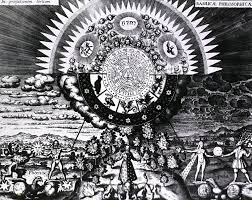
What does the ouroboros symbolize?
The Ouroboros, an ancient symbol depicting a serpent or dragon eating its own tail, holds deep symbolic meanings across various cultures. Its core symbolism includes:
-
Eternity and Infinity: The ouroboros represents the cyclical nature of life, death, and rebirth. Since the serpent forms a closed circle by eating its tail, it signifies the endless cycle of the universe and the perpetual renewal of life.
-
Self-Reflection and Unity: The ouroboros is often interpreted as a symbol of self-sufficiency and introspection. The snake consuming itself suggests that all things are interconnected and unified, emphasizing the concept of wholeness and oneness.
-
Rebirth and Renewal: Like a snake shedding its skin, the ouroboros is associated with regeneration, transformation, and the idea that destruction and creation are part of the same process. It symbolizes the constant state of renewal.
-
Duality: The ouroboros also represents the dual nature of existence—life and death, creation and destruction, beginnings and endings—suggesting that opposites are part of the same whole.
-
Alchemy and Mysticism: In alchemy, the ouroboros is a powerful symbol of the eternal cycle of creation and dissolution, often linked to the philosopher's stone and the transformation of matter. It represents the pursuit of knowledge and enlightenment.
Throughout history, the ouroboros has appeared in Egyptian, Greek, Norse, and Hindu traditions, as well as in alchemical and Gnostic texts, carrying universal themes of infinity, unity, and transformation.
2) The Infinite Ouroboros
The Ouroboros serpent has a meaning of infinity. It represents the reincarnation of things that never die, but change eternally. Time, the beginning and the cycle of life, completion, the repetition of history, the self-sufficiency of nature and the rebirth of the Earth, are also meanings that can be attached to it.
It is therefore not surprising that the Ouroboros serpent is the current mathematical symbol of infinity, in its lemniscate form. These representations of the double loop as a snake eating its tail, are also common today in art 🖼️ and fantasy literature.
It's your lucky day! From now on, you too can wear these magnificent Snake Cobra Pendant with Snake Bone Chain

3) The Double Ouroboros
The double Ouroboros is a distinct symbol from that of the simple Ouroboros. It is a more complex acronym because it is composed of two tangled snakes that eat each other's tails.
Also called Ouroboros Auryn, we don't know exactly who invented this symbol, or when. But the symbols forming the royal cartouche of Pharaoh Ramses III already contained a double ouroboros.
Some researchers suggest that the infinity sign (the mathematical lemniscate) is derived from the double Ouroboros. It was also taken up by ancient alchemists and some used it to symbolize the alchemical volatility of an element.
The Ouroboros of The Neverending Story is also a double. This "amulet of the dawn" is also at the center of the plot of the film. It was following the popularity of the film in 1984 that the two snakes eating each other's tails became a symbol in high demand among tattooists.
4) The Ouroboros: Animal... or Animals?
A) The Ouroboros Serpent, the Most Famous
The representation of the snake that eats itself comes to us from Greek and Egyptian cultures. This totem animal symbolizing cyclical rebirth due to its ability to shed its skin, it is not surprising that the Ouroboros is represented as a snake.
There are many cases of real snakes eating their own tails. And this for two reasons:
Snakes have small brains and are more reactive than proactive. Thus, they sometimes mistake the rapid movements of their own tail for prey.
Snakes are poikilothermic, their body temperature varies with their environment. If they get too hot, they can become disoriented. They then mistakenly think they are hungry and start wanting to eat at all costs. It can thus happen that they start swallowing their own tail.
Unfortunately, once the snake bites its tail, it cannot stop. Although it cannot eat itself whole, it can die trying. And form a real and macabre Ouroboros snake.
It's your lucky day! From now on, you too can wear these magnificent Snake Cobra Pendant with Snake Bone Chain

B) The Ouroboros Dragon, a Mythological Creature
In some cultures, the Ouroboros is represented as a dragon. Often, this creature takes the form of a serpent-dragon. It therefore has a rather slender shape and does not resemble the massive European dragons with large wings, such as wyverns and wyverns.
In Norse mythology in particular, the Ouroboros dragon Jörmungand is represented as encircling the world by biting its tail.
C) An Ouroboros Lizard?
The Ouroborus Cataphractus, also called the Armadilla Lizard or Cordyle Cataphracte, is a species of saurian from the South African desert. Its particularity is its armor of scales that covers it entirely. This reptile curls up on itself when it feels threatened, reminiscent of an Ouroboros.
Once it is in this position, the other parts of its body act as protection for its vulnerable belly. The Ouroboros lizard can remain in this position for up to an hour. This unique defense protects it from predators such as snakes and mongooses.
Even if it may look dangerous, apart from its fearsome scales, this Ouroboros-reptile is completely harmless to humans. However, it is threatened by poaching and illegal trade.
What is the spirituality of the ouroboros?
The spirituality of the ouroboros is multifaceted and can vary depending on the cultural context. However, some common spiritual interpretations include:
-
Unity and interconnectedness: The ouroboros often symbolizes the unity of all things in the universe, suggesting that everything is interconnected and interdependent.
-
The cycle of life and death: The serpent eating its tail can represent the constant cycle of birth, life, death, and rebirth. This can be interpreted as a natural and inevitable part of existence.
-
The eternal return: In some spiritual traditions, the ouroboros symbolizes the idea of the eternal return, suggesting that history repeats itself in cycles.
-
Self-realization: In some Eastern philosophies, the ouroboros can represent the ultimate goal of self-realization or enlightenment, suggesting that by understanding the cyclical nature of existence, one can achieve spiritual liberation.
The ouroboros can be interpreted in various ways, depending on the individual's spiritual beliefs and worldview. It can be seen as a symbol of hope, despair, or simply a neutral observation of the cyclical nature of life
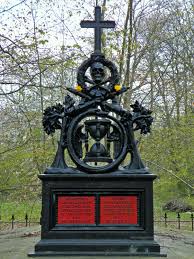
5) Origins of the Ouroboros
A) Tutankhamun's Ouroboros
The oldest traces of the Ouroboros and its origin that have been discovered date back to 1600 years BC, in Egypt. The symbol would then have been transmitted to the Phoenicians and then to the Greeks, who gave it its name.
The oldest known symbol of Ouroboros appears on a gold shrine in Tutankhamun's tomb ⚰️. It was found in the hieroglyphs in the sarcophagus chamber. The mythical serpent surrounded the feet and head of the pharaoh, symbolizing his status as an eternal divinity in the afterlife.
B) The Ouroboros, a Universal Legend
Civilizations throughout History have their Ouroboros. Even those that had no common link!
This symbol has been seen in ancient Egypt, Japan 🏯, India, Greek alchemical texts, European woodcuts, Native American tribes, and pre-Columbian temples.
The Ouroboros has sometimes been directly associated with symbols as diverse as the Roman god Janus, the Chinese Yin Yang, and the biblical serpent in the Garden of Eden. There is even an Ouroboros on the 1789 Declaration of the Rights of Man and of the Citizen!
6) Ouroboros in Mythology
A) The Ouroboros in Egypt: The Serpent of Atum
The Ouroboros appears in the Egyptian Book of the Otherworld, also called the Book of the Dead 💀. The Egyptian Ouroboros was popular after the Amarna period.
In the Book of the Dead, it is said that the sun god Atum emerged from the waters of chaos with a serpent. The animal was immortal because it renewed itself every morning. The Ouroboros in its original Egyptian context symbolized repetition, renewal, the eternal cycle of time, and sometimes even the sun itself.
The symbol refers to the "mystery of cyclical time". The ancient Egyptians understood time as a series of repeating cycles, rather than something linear and ever-changing. Central to this idea was the flooding of the Nile and the journey of the sun.
A famous drawing of the Ouroboros also appears in the alchemical text The Chrysopoeia, by "Cleopatra the Alchemist" (an Egyptian, different from the queen-goddess Cleopatra). It is a very old alchemy treatise dating from the 2nd century in Alexandria, which addresses the subject of the Philosopher's Stone 💎. We will return to this point in the section on alchemy.
It's your lucky day! From now on, you too can wear these magnificent Snake Cobra Pendant with Snake Bone Chain

B) The Greek Ouroboros: the Primordial Being
It was the Greeks who gave its name to the Ouroboros. The Greek philosopher Plato described a circular and self-consuming being as the first divine being in the universe. As he was absolutely alone in the cosmos, this primordial being had some peculiarities:
- He had no eyes because there was nothing to see outside of him
- No ears because there was nothing to hear
- No lungs because there was no atmosphere to breathe
- No organs to eat or drink, because there was no food and no water
- No limbs because there was nowhere to go, no one to defend himself against, and nothing to catch
This is how the Ouroboros of Greek Philosophy was created: his own waste providing his food. Everything that influenced his existence having been caused by himself. The Alpha and Omega of the Cosmos, the beginning and end of all things.
Given his condition, a spherical shape was given to him by the creators so that he could perform an infinite circular movement on himself ⭕. The Greek Ouroboros thus symbolized eternity and the soul of the world.
The essence of the Ouroboros is also present at another level in Greek mythology. It is the representation of natural forces. Like the sun, the moon 🌙, the waves of the sea, …
This snake is also linked to the myth of Sisyphus and Helium. In this legend, Sisyphus is forced to push a heavy, perfectly round stone up a steep slope 🏔️. But before reaching the top of the hill, the stone rolls all the way down. Sisyphus is therefore condemned to start over every day from the bottom of the hill, and this for eternity.
Contrary to popular belief, the Aesculapian snakes wrapping around the caduceus of Hermes are not related to the symbol of the Ouroboros, but symbolize trade. The same goes for the Staff of Asclepius with a snake wrapped around it, symbol of medicine.
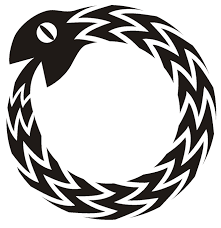
C) Jörmungand: the Viking Ouroboros and its Meaning
In Scandinavian culture, the Serpent Jörmungand (or Jormungandr) is one of the three children of the deities Loki and Angrboda. This titanic monster is so large that it can encircle Midgard, the world of mortals, by grabbing its tail between its teeth.
Jörmungand the Ouroboros guards Yggdrasil. Moreover, it is often represented as the Ouroboros of the Tree of Life.
According to legend, when the Ouroboros Jormungandr releases its tail, it will come to destroy the world during Ragnarok.
Thor himself fought the Norse Ouroboros but failed to kill it.
In the Norse legends of Ragnar Lodbrok, a king gives a gift to his daughter Pora Town-Hart 🎁. After which it turns into a large serpent and surrounds the girl's tent biting its tail. Ragnar Lodbrok then kills it and marries Pora. Ragnar later has a son with another woman named Kraka. This son was born with a white serpent shape biting its tail in one of its eyes, and is thus named Sigurd Serpent-Eye 👁️.
viking ouroborosToday it is common to combine the Ouroboros with a Viking or Celtic rune. This trend is rather modern, as these symbols were rarely merged in the time of the proud Vikings and Celts.
The Ouroboros Vegvisir and the Ouroboros Valknut are very popular among lovers of snake tattoos and Viking jewelry. The Vegvisir rune symbolizes orientation and protection, and the Valknut or "Knot of the Fallen" refers to the proud warriors of Odin who fell in battle.
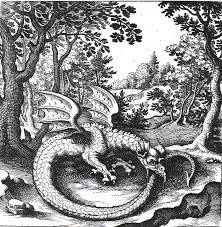
D) The Asian Ouroboros: the Yin-Yang
The Ouroboros in Buddhism and Chinese mythology is assimilated to the symbol of Yin-Yang and the connection of opposites. In Chinese culture, the universe was divided between Earth (below) and Heaven (above). These gave the idea of opposites forming a unity.
Each of the opposites is powerful, and their final unity is also. For the creation of the universe, the creators imagined reproduction to design new things. Today, reproduction results in the union of two opposites: man 👨 and woman 👩.
The Chinese believed that Light and Darkness, as ideal opposites, produced creative energy when united 💫. The two opposites were Yin and Yang, and their unity was called Chhi. The Chinese Ouroboros symbolizes this unity.
The Yin-Yang was probably transformed into a symbol called Ouroboros when Chinese alchemy reached Alexandria 🗺️. It is a snake, so it is the symbol of the soul. The head and front of this Yin Yang Ouroboros are light like the soul. Its tail and back are dark, representing the body. The soul and the body being two opposites uniting to form a whole: Man.
The Ouroboros is represented here in white and black. It is the cosmic soul, the source of all creation. We find this symbolism of what is similar to the Ouroboros of Japan in Japanese mythology and Reiki.
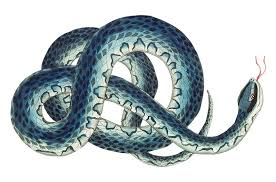
E) Mesoamerica: Mayan and Aztec Ouroboros
Pre-Columbian civilizations had similar gods. For example, it is likely that the serpent god Quetzalcoatl, worshipped by the Aztecs and Toltecs, was worshipped by the Mayans under the name of Kukulkan.
This Kukulkan Ouroboros is sometimes depicted biting its tail on Mayan ruins.
Quetzalcoatl was a good god, who brought knowledge to his people. An Aztec Ouroboros Quetzalcoatl is carved on the base of the Pyramid of the Feathered Serpent dating from 650, in Xochicalco, Mexico.
The meaning of the Ouroboros is unclear in Aztec society. But the practice of human sacrifice to Quetzalcoatl indicates that it was probably meant to symbolize the link between the world of the living and that of the gods and/or the dead 💀.
F) The Ouroboros in Yoga and Hinduism
In Indian Sanskrit mythology, a dragon surrounds the turtle that carries on its back the four elephants supporting the world. It is sometimes found artistically illustrated as Ouroboros Mandala.
In Yoga, the snake that eats its tail has two meanings:
- The Ouroboros of Kundalini symbolizes the concentration of spiritual energy located in the lower spine and influencing the Chakras. Here is how Kundalini is described by Buddha in the sacred Hindu texts: "The Kundalini shines like the stem of a young lotus; like a snake, coiled on itself, it holds its tail in its mouth and rests half asleep as the base of the body".
- The Ouroboros of Karma in Sanskrit symbolizes the infinite cycle of causes and consequences of the actions of Buddhists. And the consequences of this on its cycle of reincarnation.
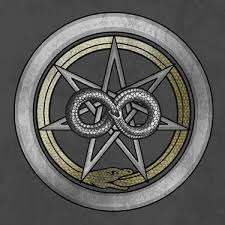
G) The Ouroboros in Islam and the Zoroastrian Farvahar
The Albigensians (followers of Catharism, not to be confused with the Albigensians who are the inhabitants of the city of Albi in France) came from Armenia. In this region, Zoroastrianism (a monotheistic religion of ancient Iran) and representations of the Iranian god Mithras were common. The Ouroboros may have entered their iconography through the emblem of the Zoroastrian Farvahar, which in some versions clearly presents an Ouroboros at waist level rather than a simple disk.
In cults, the figure of Mithras being reborn is sometimes represented wrapped in an Ouroboros, indicating his eternal and cyclical nature 🔁. Even references that do not mention these creatures, attest to this circular shape as a symbol of the immortality of the soul or the cyclical nature of karma.
H) Ouroboros in European Astrology
In ancient European mythologies, Ouroboros is also an astrological symbol representing the Milky Way 🌌. The myth refers to a "Ouroboros Constellation", a serpent of light residing in the heavens between the stars. According to cosmic legends, this serpent would eat its own tail.
It is in fact the constellation of Ophiuchus also called Serpentarius or Serpentarius, located between the constellation of Scorpio and that of Sagittarius. This constellation is listed in Ptolemy's Almagest and is visible between 80° North and 80° South. It represents a man holding a snake in his hand.
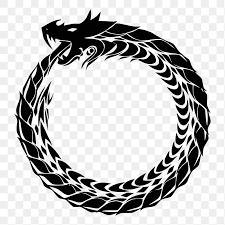
I) Ouroboros in the Christian Religion and the Bible
Christians adopted Ouroboros in the Bible as a symbol of the difference between the inside and the outside of the world, according to the closed system vision of the universe 🌀. In Genesis the spiritual symbol of the Ouroboros also personifies the transitory and self-consuming nature of a mere existence, following in the footsteps of the preacher in Ecclesiastes (book of the Hebrew Bible).
J) The African Ouroboros: Aido Hwedo
Snakes are sacred in many West African religions 🌍. The demigod Aido Hwedo is often represented by the image of a python biting its tail. He is said to be at the origin of the creation of the world.
The Ouroboros is also present in the iconography of the Fon people or the Dahomeya people, as well as in Yoruba imagery such as Oshunmare.
K) The Ouroboros in Gnosticism
Gnosticism is a movement of thought taking place in the 2nd and 3rd century in the Roman Empire. According to Gnostic philosophy, humans are divine souls, locked in mortal bodies by a malevolent god.
The Ouroboros were important to the Gnostics. The opposition between the head and tail of the Ouroboros was interpreted as divine. They transposed this to the soul and body in man. Two components a priori contrary, but which together formed a whole: Man. This Manichean vision (clear distinction between soul and body), echoes the Zoroastrian philosophy of the farvahar.
It's your lucky day! From now on, you too can wear these magnificent Snake Cobra Pendant with Snake Bone Chain

What does ouroboros metaphor mean?
The ouroboros metaphor represents a variety of profound and interconnected meanings, often linked to cycles, self-sufficiency, and duality. Here are the key metaphorical interpretations:
-
Endless Cycle: The ouroboros, a serpent eating its own tail, is a metaphor for eternal cycles. It reflects the repetitive nature of life, where creation and destruction are intertwined. This can apply to the cycle of nature, personal growth, or even cosmic processes.
-
Self-Sufficiency: As the ouroboros consumes itself, it symbolizes self-reliance and self-containment. Metaphorically, it represents something that is self-sustaining, able to perpetuate itself without external influence, like an idea or system that draws on its own resources.
-
Duality and Unity: The ouroboros can also be seen as a metaphor for unity in opposites. It encapsulates the idea that opposing forces (life and death, creation and destruction) are part of a single whole. This can represent balance in the universe or within oneself, suggesting that opposites are not in conflict but are complementary.
-
Transformation and Renewal: As a metaphor, the ouroboros signifies renewal through transformation. Like a snake shedding its skin, it illustrates that change and transformation are necessary for growth and that new beginnings often come from endings.
-
The Infinite Loop: The ouroboros is often used as a metaphor for something that is continuous or self-perpetuating, such as an endless cycle of cause and effect, or in modern contexts, a self-referencing or recursive process. It can represent a paradox, where the beginning and end are one and the same.
In essence, the ouroboros metaphor touches on concepts of eternity, self-reliance, transformation, and unity, making it a powerful symbol in philosophical, spiritual, and even scientific contexts.
7) Ouroboros in Alchemy
A) Origin of the Ouroboros
in AlchemyThe earliest appearance of this symbol in alchemy is in an alchemical treatise dating from the second century, written by Cleopatra the Alchemist.
The alchemical manual Chrysopoeia (chrysopoeia being the making of gold 💰 by transmutation) by Cleopatra contains a drawing of the ouroboros representing the serpent half light and half dark. This sign illustrates the dual nature of things, but above all that opposites are not in conflict, quite the contrary. The book is mainly centered on the idea that "one is all". A concept that is linked to hermetic wisdom, a concept belonging to the world of esotericism.
Like the sun, the Ouroboros has made its own journey. From Egypt, it found its way to the Greek alchemists of Alexandria.
This treatise on chrysopoeia also came to us via Greek sources, and we were able to discover on the parchments the famous Greek inscription εν το το παν: hen to pan, "one is all". This well-known maxim in alchemy teaches that inside everything that is good 😇, there is something bad 😈. And inside evil, there is always something good.
It's your lucky day! From now on, you too can wear these magnificent Snake Cobra Pendant with Snake Bone Chain

B) The Ouroboros as an Alchemical Symbol
In the esoteric practice of alchemy, this symbol expresses the unity of all things, material and spiritual. It expresses the fact that they never disappear but change form in a continuous renewal, and an eternal cycle of destruction 💥 and creation 💫. A snake is often a symbol of resurrection, because it seems to be continually reborn by shedding its skin when it molts. This is increased tenfold with the Ouroboros which turns in circles on itself, while eating its own tail!
The Ouroboros in alchemy also symbolizes:
- The spirit of Mercury, the substance that permeates all matter: the Prima Materia
- The cycle of life and death
- The conscious and the unconscious
- The eternal unity of all things
- The cycle of birth and death, whose secrets the alchemist sought to uncover 🔎
Here again we find the universal meaning of this snake: the harmony and unity of opposites. In alchemy, the Ouroboros symbolize the work of the alchemist who unites opposites.
Alchemically, the snake coiling on itself is also used as a purifying glyph ✨.
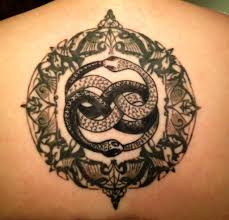
C) Renaissance Alchemy
The Ouroboros continued to enjoy great popularity among Renaissance alchemists. Representing once again the infinity of time and eternity, this symbol of the serpent was considered by alchemists as the ultimate obstacle to overcome in the Opus Magnum 📕.
Because becoming immortal (their primary goal) meant breaking the incessant cycle of the Ouroboros once and for all. Possessing the precious philosopher's stone that would bring them unheard-of wealth was just the cherry on the cake 🍒.
Renaissance alchemists therefore saw the Ouroboros as a vision that had to be escaped. They were thus in search of a linear rather than cyclical eternity.
It's your lucky day! From now on, you too can wear these magnificent Snake Cobra Pendant with Snake Bone Chain

What does the ouroboros symbolize in Christianity?
In Christianity, the ouroboros is not a traditional or commonly used symbol, but when it does appear in Christian contexts, it carries meanings that overlap with broader spiritual themes while also being interpreted through a Christian lens. Here's what the ouroboros can symbolize in Christianity:
-
Eternal Life and Resurrection: The ouroboros, as a symbol of the cyclical nature of life, can be seen to metaphorically align with the Christian belief in eternal life and resurrection. Just as the snake continuously consumes itself, representing renewal, it can symbolize Christ's resurrection and the promise of eternal life after death for believers.
-
Alpha and Omega: In Christian theology, God is often described as the "Alpha and Omega" (the beginning and the end). The ouroboros, with its circular form and the lack of a clear beginning or end, can reflect this idea of God's eternal presence in both the creation and ultimate conclusion of the universe.
-
Divine Infinity: The ouroboros’ depiction of an endless cycle can also symbolize God's infinite nature in Christian belief. It reflects the idea that God's existence transcends time, with no beginning or end, much like the circular form of the ouroboros.
-
Fall and Redemption: In a Christian context, the ouroboros could be interpreted as a symbol of humanity's fall and redemption. The cycle of the serpent consuming itself could metaphorically represent the sin (fall) and eventual redemption (renewal) of humankind through Christ.
-
Sin and Temptation: On a more negative note, since the serpent is a key symbol of Satan and temptation in Christian tradition (as in the story of Adam and Eve), the ouroboros could also be interpreted as a representation of sin’s cyclical and self-destructive nature. It may symbolize how sin leads to repeated moral failings unless one breaks free through faith and repentance.
While the ouroboros is not a standard Christian symbol, when it does appear, it is often reinterpreted through a theological lens to align with Christian teachings about eternity, resurrection, and divine infinity.
It's your lucky day! From now on, you too can wear these magnificent Snake Cobra Pendant with Snake Bone Chain

8) The Ouroboros in Secret Societies
A) The Ouroboros and the Albigensians
The Ouroboros symbol appears in Albigensian watermarks from the 14th and 15th centuries, and is also used in playing cards and tarot cards from the period 🃏. A commonly used ancient symbol: an ace of cups surrounded by an Ouroboros, appears frequently among Albigensian watermarks. It is conceivable that this is the source of some urban legends associating this symbol with secret societies, as the Albigensians were closely associated with the humanist movement and the inquisition it sparked 🤔.
B) Ouroboros and Freemasonry
The Ouroboros is a Masonic symbol depicted on many seals, frontispieces, and other images, especially during the 17th century. It is always depicted in the company of other symbols of Freemasonry.
This sign is also present in the seal of the Theosophical Society, alongside other traditional and spiritual symbols.
C) An Illuminati Ouroboros?
The image of the serpent coiling on itself appeared centuries before the official formation of the Illuminati.
In Illuminati initiatory rituals, the Ouroboros represents the circle of life: the passage of humanity through generations that begin and end, in a constantly renewed cycle. It shows the path to physical mortality, the inescapable truth that all life begins with nothing and ends in the same place it began 😕. All humans are born from dust, and to dust they will return…
D) Ouroboros, Satanists and Occultism
The Ouroboros is present in some Satanist rituals. They divert its primary meaning in order to make it an Ouroboros of Satan and draw its evil potential. Indeed, as a symbol of balance, this snake contains an occult part because it represents both good and evil.
It is therefore found in incantations to the glory of Satan and demons. The devil is then represented by Ouroboros Hexagram or Ouroboros Leviathan. It appears on pentagrams, Sigils and pentacles supposed to open passages to hell. But also in all kinds of magical occult rituals.
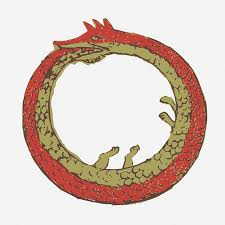
9) The Ouroboros in Psychology
The Swiss psychologist Carl Jung interpreted the Ouroboros as having a powerful meaning in the human psyche 🧠. This snake makes its way into our conscious mind many times, in various forms. Jung defined the relationship of the Ouroboros to alchemy: "In the image of the Ouroboros is the idea of devouring oneself and reincarnating psychically in a new light".
The Ouroboros is a symbol of integration and assimilation of the opposite, that is, of the shadow side. This process is at the same time a symbol of immortality, since the Ouroboros is said to kill itself and come to life, fertilize itself and give birth to itself 🤯. It symbolizes the Unique, which is born from the meeting of opposites. In this, this imaginary reptile constitutes the secret of the prima materia. In psychology, the prima materia refers to the unconscious.
Jungian psychologist Erich Neumann speaks of this snake as a representation of the State of Dawn. For him, the Ouroboros is the link between the childhood of humanity as a whole, and the childhood of a single individual.
The cyclical symbolism of this snake can also be interpreted in psychology as the eternal effort to put an end to the problems of life. But since the cycle starts again, the effort is useless because the problems come back tirelessly ☹️.
It's your lucky day! From now on, you too can wear these magnificent Snake Cobra Pendant with Snake Bone Chain

10) The Ouroboros in Chemistry
And yes, the symbol of the Ouroboros is present even in scientific spheres! 😮
The 19th century German chemist August Kekulé described the day he made one of his most important works in chemistry. He says that he was working with his textbook, but since he couldn't move forward, he fell asleep 💤. In a dream, he saw how the atoms changed before his eyes in the form of a snake in the shape of a circle. When he woke up, this vision encouraged him to work the rest of the night on his hypothesis.
His research focused on the molecular structure of benzene 🔬. Thanks to his dream, he understood that the structure of this molecule was a closed carbon ring. This was the breakthrough he needed. So a chemist discovered the benzene ring thanks to an illumination from Ouroboros!
11) The Ouroboros, Tattoo and Meaning
The Ouroboros is a very fashionable tattoo because of its deep symbolism. The meaning of an Ouroboros tattoo is infinity, the cycle of life and death, rebirth, duality, longevity, and wholeness. It is a retrospective tattoo inviting introspection on oneself, one's life and one's spirituality.
Getting an Ouroboros tattoo means achieving balance in one's personal development. Most people get an Ouroboros tattoo because the meaning of this tattoo evokes something for them. But some may do it in connection with their religion.
There are many forms of Ouroboros in tattoos:
- Classic or lemniscate Ouroboros tattoo
- Black or drawing Ouroboros
- Tribal Ouroboros with a warrior aspect on the forearm
- Ouroboros in tattoo for women
- Ouroboros in tattoo on the wrist
- Infinite tattoo in the shape of an Ouroboros
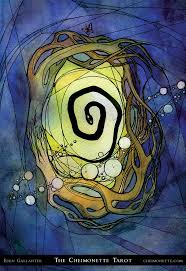
12) Other Famous References to the Ouroboros
Many Crop Circles (the shape of gigantic circles appearing in fields 🌽) are in the shape of Ouroboros
"Ouroboros: the bloody imprint", a novel by Franck Thilliez
Ouroboros Full Metal Alchemist: in this famous manga, the homunculi sport a tattoo in the shape of Ouroboros
It's your lucky day! From now on, you too can wear these magnificent Snake Cobra Pendant with Snake Bone Chain

Conclusion: The Ouroboros in Jewelry
Now you know everything about the famous snake biting its tail! But do you know how to appropriate its symbolism?
The Ouroboros is a timeless piece of jewelry. True figurative creations, Ouroboros Snake Label jewelry combines deep meaning and majestic minimalism. Symbols of energy and balance, they are charming everyday companions.
The uniqueness of the Ouroboros is suitable for the most daring jewelry boxes. The elegant circularity of this lucky totem mimics the continuous rhythm of the universe, its association with infinity, and therefore eternal love.💕
Are you passionate about snakes? Us too! That's why we founded Snake Label®: to share our passion for this reptile with as many people as possible.
Whether through our Snake Jewelry or our Snake Clothing, we strive to offer a wide range of quality artisanal products, made to order 👌. The latter are aimed as much at terrarium enthusiasts as at people looking for an original style.
Dive into the fascinating world of snakes and explore our other articles now!
Stay Updated!
Don't miss out on the latest insights, tips, and exclusive content. Subscribe to our blog newsletter today and be the first to know about new posts, special offers, and more!
Join our community now—just enter your email below to stay connected